Published: 14 November 2017
Men remarry more often than women
According to Statistics Finland's data on population changes, remarriage is more common for men than women. Men’s remarriage is also more common when examined by age group, except for persons aged under 35, where women’s remarriage was more common than men’s for the second year in a row. Remarriage decreases gradually with age.
Remarriage rate by age and sex 2016
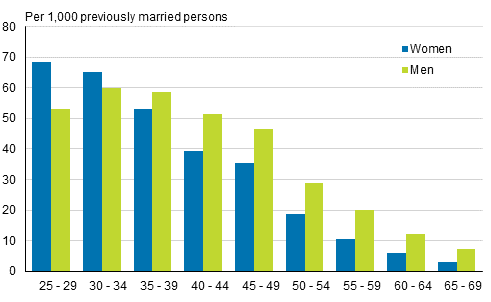
In 2016, the number of persons getting remarried remained almost unchanged from the previous year, being 6,200 marriages for women and 6,500 for men. Over the past good ten years, the annual changes in the number of remarriages have been small measured by volume. After 2008, the remarriage rate decreased as did the marriage rate in general, but in recent years, the remarriage rate has picked up a bit, unlike the marriage rate. The figure shows the development of the remarriage and marriage rates for women as they are the same as for men. The figures calculated based on men are simply higher than those for women.
Marriage rate¹ and remarriage² rate 1990–2016

1. Married women per 1,000 non-married and women not in registered partnership of respective mean population aged 15 and over.
2. Remarried women per 1,000 previously married women of respective mean population.
People marry at an older age
Persons who enter into marriage are getting older. One reason for a later first marriage is that for nine out of ten people the first union is in the form of cohabiting. In addition, the number and share of persons who enter into at least a second marriage have increased, which in turn has increased the number of annual marriages entered into by persons aged 35 or older, for example.
In 1990, eighty per cent of all women, who entered into marriage were aged 20 to 34 and in 2016, the share was only 60 per cent. The development is similar for men in the same age group, the share decreased from 77 to 52 per cent. In 1990, the share of women, who entered into their first marriage at the age of 35 or older, was five per cent of all marriages entered into, and in 2016, the share had grown to 18 per cent.
The fact that the first marriage starts at an older age is visible in the development of marriage rates by age group. Because the trend of the marriage rate has been more steeply rising in older age groups than in younger ones and because, in recent years, it has also been declining for those aged 25 to 34, persons that enter into their first marriage are ever older.
Even though the marriage rate for first marriages has been rising in relative terms considerably in older age groups, the number of marriages entered into is not high: 537 first marriages for persons aged 50 to 64, which corresponds with three per cent of all first marriages entered into in 2016.
First marriage rate by age 2016
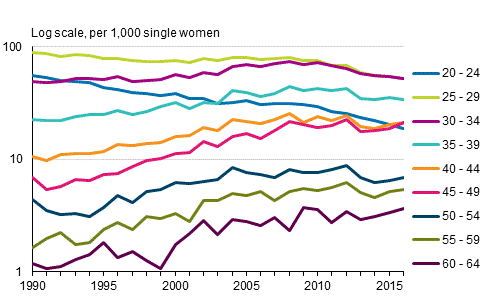
From the beginning of the 1980s, the average age of persons entering into their first marriage has risen from 25 to 31 years for women and for men from 27 to 34 years by 2016.
In a comparison of European countries, Swedish men and women are the oldest when entering into their first marriage. Swedish men are, on average, aged 36 and women 34 when they get married for the first time. Correspondingly, Romanian people are the youngest when entering into their first marriage, women are, on average, 27 and men 29 years old. In an age comparison, Finnish men are the eight oldest and women the seventh oldest when comparing 25 countries.
Mean age at first marriage in some European countries 2015, women
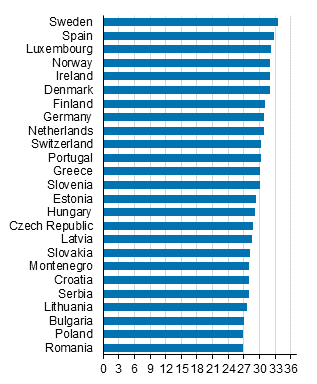
Mean age at first marriage in some European countries 2015, men
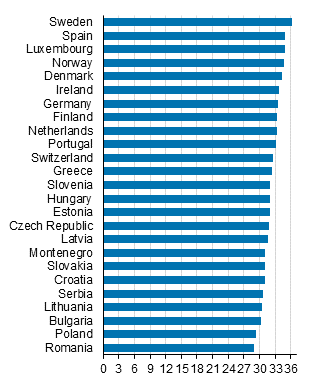
Marriages have become more international
Finnish women married spouses representing 120 different nationalities in 2016. The number of nationalities among the spouses can actually even be a bit higher because nearly 100 persons had no nationality. In 1990, Finnish women married men representing 84 different nationalities. Nearly 40 spouses had no nationality data so the above-mentioned number can be slightly higher.
The number of nationalities for Finnish men’s spouses is slightly lower than that of women, in total 108 different nationalities. In addition, a small number of men’s spouses had no nationality, so the variation of nationalities can be slightly higher than mentioned above.
Altogether, 2,700 women, of whom 1,900 were Finnish citizens, and 3,150 men, of whom 2,000 were Finnish citizens, entered into marriage with a foreign citizen in 2016. Women, who were Finnish nationals, most commonly married Iraqi (135), Turkish (123) and British (111) citizens.
Men, who were Finnish nationals, most commonly married Taiwanese (357), Russian (300) and Vietnamese (121) citizens in 2016.
There are more data on marriages and divorces between Finnish and foreign citizens on the Immigrants and integration thematic pages .
The number of divorces has varied between 13,000 and 14,000 since 1989.
In 2016, altogether 13,541 marriages ended in divorce, which is 398 fewer than one year previously. When the Marriage Act was amended in 1988 to make divorcing easier, the number of divorces rose to a record level where it has remained. Prior to the amendment, the number of divorces varied between 9,000 and good 10,000 from 1974 to 1987.
In the whole country, 14 women per one thousand married women got divorced in 2016. By comparison, the divorce rate among Swedish-speaking women is only eight women per one thousand married women.
How many marriages end in divorce?
In 2016, the probability that a woman’s first marriage ends in divorce was 39 per cent. The rate is on level with that of the years 2005 to 2015, when it varied between 38 and 40 per cent. An interesting fact is that a first marriage ending in widowhood is slightly more probable than the marriage ending in divorce. The above-mentioned probabilities are based on the events of one year based on which the probability that an event takes place is calculated. In that case, e.g. the divorce rate can be summarised in one figure. Similar results can be reached by examining all marriages entered into in a particular year that end in divorce by the duration of the marriage, but in this case, there are as many divorce rates as years in which marriages are entered into.
Since the 1990s, the divorce rates by the duration of the marriage are very similar and are thus not dependent on the year in which the marriage was entered into. For example, one-fifth of the marriages entered into in 1990, 1995, 2000 and 2005 had ended in divorce in nine years and one-quarter in 12 years, except for marriages entered into in 2005 for which this already happened in 11 years.
Divorce rates cumulated for women entering into marriage in certain years by the end of 2016
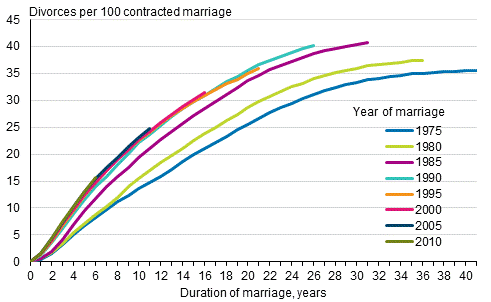
The divorce rate is highest thus far for marriages entered into in 1985 of which 41 per cent had ended in divorce by the end of 2016. If the divorce rate remains at the level where it has been for a long time, it is highly possible that the other marriage cohorts of the late 1980s and those of the 1990s will reach the same divorce rate level as those who entered into marriage in 1985.
The risk of divorce grows steeply during the first years of marriage. The risk is highest in the third year. After the peak for divorcing is reached, the risk of divorce decreases very similarly in all marriage cohorts.
Divorces by year entering into marriage and duration of marriage, women
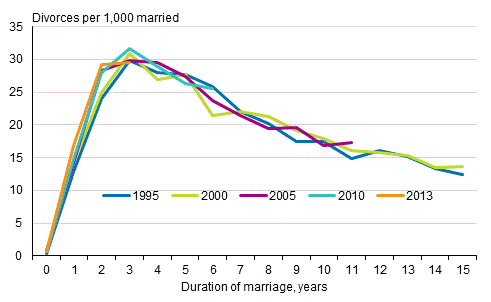
Female partners are younger when registering their first same-sex partnership than male partners
The average age of the younger partner when female couples register their first same-sex partnership was 31.5 years and the average age of the older partner was 36.3 years in 2016. The average age of the younger partner has varied between 31 and 33 years in 2007 to 2016. Correspondingly, the average age of the older partner has varied between 35 and 38 years.
For male couples registering their first same-sex partnership, the average age of the younger partner was 34.6 years and that of the older partner was 43.4 years. The average age of the younger partner has varied between 33 and 37 years since 2007. Correspondingly, the average age of the older partner has varied between 41 and 46 years.
The average age of male couples that have registered their first same-sex partnership has fluctuated without a clear direction, unlike that of female couples. For female couples, the average age has a slightly decreasing trend, that is, the partners are slightly younger than before. So the development in the average age is different from that for persons entering into their first marriage.
Mean age of partners at first registered partnership 2002–2016
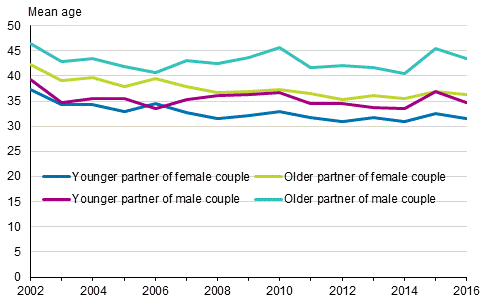
Registered partnerships end in divorce more often than marriages
In 2016, the divorce rate from registered partnerships was 22 per one thousand couples, while the corresponding divorce rate for marriages was 14 per one thousand couples.
There has been a clear difference in the divorce rates of male and female couples as female couples’ divorce rate has been clearly higher than that of male couples since 2004. In 2016, the divorce rate for male couples was 17 per one thousand couples, while for female couples it was 24. For registered partnerships, the direction of the divorce rate is slighty growing, while the divorce rate from marriages has remained almost unchanged.
Divorce rates from registered partnerships and marriages
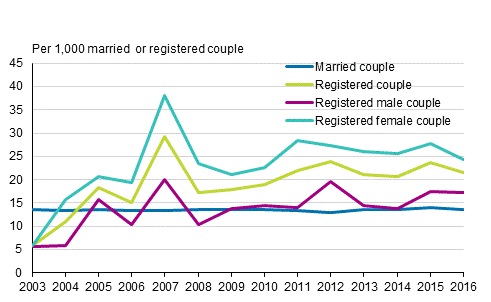
Source: Changes in marital status 2016. Statistics Finland
Inquiries: Timo Nikander 029 551 3250, info@stat.fi
Director in charge: Jari Tarkoma
Publication in pdf-format (369.6 kB)
- Tables
-
Tables in databases
Pick the data you need into tables, view the data as graphs, or download the data for your use.
Appendix tables
- Appendix table 1. First marriage rate by age and total period first marriage rate 2006 - 2016 (14.11.2017)
- Appendix table 2. Newly married women by age and age of spouse 2016 (14.11.2017)
- Appendix table 3. Marriage rate by region 2006 - 2016 (14.11.2017)
- Appendix table 4. Divorces by age of spouses 2016 (14.11.2017)
- Appendix table 5. Divorces by age of mother and children aged under 18 in 2016 (14.11.2017)
- Quality descriptions
-
- Quality description, changes in marital status (14.11.2017)
Updated 14.11.2017
Official Statistics of Finland (OSF):
Changes in marital status [e-publication].
ISSN=1797-643X. 02 2016. Helsinki: Statistics Finland [referred: 17.12.2025].
Access method: http://stat.fi/til/ssaaty/2016/02/ssaaty_2016_02_2017-11-14_tie_001_en.html

